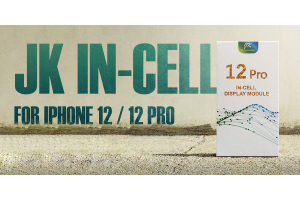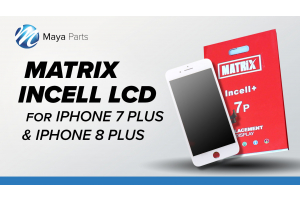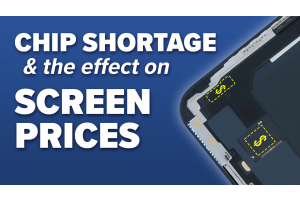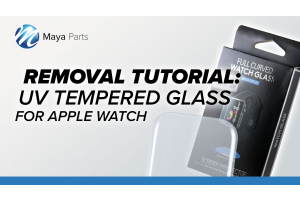We use cookies to make your experience better. To comply with the new e-Privacy directive, we need to ask for your consent to set the cookies. Learn more.
Blog
-
July 12, 2021
Come see us at AWPE 2021!
Maya Parts will be attending the All Wireless and Prepaid Expo 2021! This event will be taking place from August 17-18, 2021 at Caesar’s Palace in Las Vegas. This will be our first big event in over a year and we are excited to see you all in person! We will have samples on hand, as well as information and giveaways, so if you’re in the area, stop by and say hi!
AWPE is the perfect industry event for small mobile shops, including those that offer repair services! It hosts networking events, informational conferences and workshops, and a wide variety of industry vendors! This will be our second time at this event and we are looking forward to introducing our services to repair professionals like you! Take a look at the event website for more information about the specific resources and vendors that will be in attendance.
Are you ready to attend? Then we have great
-
July 09, 2021
JK's New In-cell Display Makes 12-Series Repairs More Accessible!
The iPhone 12 series of devices have turned out to be incredibly popular. In a little more than half a year, Apple has sold more than 100 million 12-series devices- something it has not done since the iPhone 6. Because of that, the number of customers needing 12 series repairs will likely be higher than with previous iPhone models (when those were new). But as price-conscious customers will be surprised to learn, replacement displays for current-model phones can be prohibitively expensive. So how can repair shops cater to those who can’t afford a new screen for their iPhone 12? Now, JK, one of the industry’s most well-known brands for its consistent and great quality, has an answer!
JK has just released a version of their popular In-cell LCD display for iPhone 12 and 12 Pro! This is the most economical iPhone 12 screen on the market and now it’s available here at Maya Parts! Best of all,
-
April 22, 2021
Introducing Matrix Incell Displays for iPhone 7 Plus and 8 Plus!
If your shop performs a lot of repairs on older iPhones, then you’ll want to take a look at our newest product- Matrix DTP Incell Displays for iPhone 7 Plus and 8 Plus! These are aftermarket screens, but they rival original iPhone screens in quality and feature set.
These Matrix screens score exceptionally well in many areas, including touch response, polarizer viewing ability, fit, and screen coating. The standout feature though, is the incredible display on this product. Matrix has gone out of their way to match these screens as closely as possible to their OEM counterparts. In terms of color accuracy and brightness, the Matrix Incell screens are very close to OEM. Take a look at our highlight video to see them in action!
-
March 03, 2021
If you’ve been following the news lately, you’ve likely heard of the global chip shortage that is affecting the automotive, PC, and video game industries. Unfortunately, the widespread use of microchips means that this shortage is inevitably spreading to other industries, and now that includes cell phone repair. Currently, we’re seeing higher costs for aftermarket screens, particularly those for iPhone 7 through iPhone XR. We are hoping that these increases will remain restricted to those models, however, it’s possible that more will be included if the supply issues are not resolved.
What is causing this shortage?
There are actually several different factors causing these supply constraints.
-
February 23, 2021
One of the most asked questions on our YouTube channel is how to remove our Apple Watch UV tempered glass. So we recently put together a quick little video that demonstrates exactly that.
Many people are understandably hesitant to try and remove this type of screen protector, because of the strength of the bond. But it’s actually pretty straightforward, once you know how to do it. The main thing to remember is that you need to interrupt that bond between the adhesive and the screen glass. Once that is done in one spot, the rest of the adhesive is much easier to remove.
Take a look at the video below for the demonstration.
-
February 23, 2021
Severe weather is delaying shipments- but don't worry, we've got your back!
As you’re certainly aware, severe weather is making things difficult for people all across the country, and that includes our shipping carriers. Because of this, some shipments are arriving later than planned, depending on weather conditions or transport ability. If you’re located in any of the affected areas, or are far from the west coast, please select a higher shipping tier in order to reduce the chances of a late order.
That being said, we cannot guarantee that orders will arrive when expected, even at higher shipping tiers. Carriers are doing everything they can to reduce the chances of delays, and to help, we will refund shipping costs for any next-day-air orders that are delayed from their scheduled arrival. Terms and conditions apply and these refunds will only be available until mid-March, depending on weather. Maximum shipping refund is $100 per order.
-
February 12, 2021
We’ve added C11 and DTP classification to select 7P and 8P screens!
You may have noticed the new additions to our iPhone 7 Plus and iPhone 8 Plus line-up. These are new AA and incell options labeled DTP (LG) and C11 (Toshiba). If you’re new to the iPhone repair industry, you may not have come across these codes yet. However, since 7 and 8 series repairs are more common than they used to be, it’s important to be aware of these codes in order to get the correct part for your repair.
What do these terms mean?
These codes are actually part of a longer set of serial numbers (typically the first 3 characters) printed on the back of OEM
-
February 08, 2021
Check out our latest YouTube video for a look at this great product!
Here at Maya Parts, our goal is to best serve our customers in any way that we can, and that often means going beyond just replacement parts. Recently, we started carrying a selection of QianLi Tools- a brand of quality, high-precision tools made just for the phone repair industry! Many of you are probably already familiar with their beautiful line of iThor screwdrivers, but maybe not with their more technical offerings.
One example is the iCopy Plus 2.1 Logic Programmer. This durable and compact device is a great tool for any iPhone repair technician. The iCopy duplicates and transfers data between original and replacement screens, vibration motors (aka Taptic Engines), and batteries. This allows technicians
-
January 26, 2021
Since we started selling individual QianLi screwdrivers, a few of you have asked which drivers you need to work on a specific model of iPhone. The easy answer is that you need all four for iPhone 7 and up (consider picking up the iThor or iFlying 5-piece set- both include all four iPhone screwdrivers, plus a torx driver for other electronic devices). But the more precise answer is that it depends on which repairs you need to perform. So here’s a breakdown of each driver and what it’s accompanying screw is used for. We also have a quick chart at the bottom explaining which screwdrivers are needed for screen replacements, based on model.
Types of Screws
-
December 23, 2020
Have You Experienced Touch Issues on the iPhone 11?
Apple recently launched a repair program for certain models of the iPhone 11 that are experiencing touch screen problems. According to their announcement, a small percentage of phones are experiencing a loss of touch response due to a flaw in the display module of specific iPhone 11 models. This issue specifically affects devices manufactured between November 2019 and May 2020, and customers can check to see if their particular phone is affected by visiting the repair program’s web page. If their phone is affected, they can apply to get it repaired free of charge.






